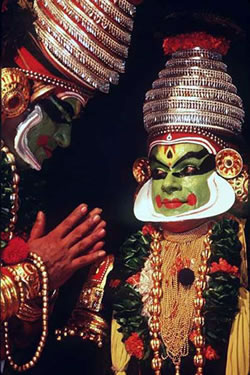 Kathakali dance drama is one of India's most remarkable performing arts. An operatic spectacle involving pantomime, abstract dance, singing, instrumental accompaniment, and elaborate, stylized costumes and makeup, it is truly a multimedia presentation. Kathakali, which literally means "story play," was developed in the 17th century in Kerala as a courtly dance drama enacting mythic stories of the Hindu gods and goddesses. Based on the ancient Sanskrit theater tradition outlined in the second- century treatise, Natya Sastra, Kathakali has incorporated elements of older theatrical styles such as Kutiyattam and Krishnanattam, as well as influences from the rich tradition of possession performances found throughout the region. These latter ritual traditions emphasize blood sacrifice, orchestral drumming and spirit possession by fierce deities who are worshipped with dancing and story-telling. Although Kathakali has always been conceived of as a form of theater, not a possession ritual, the original performances took place over many nights in temples as a sacred offering. Today, Kathakali has become increasingly a commercial entertainment, condensed to a few hours and presented in theaters. Still, the original vitality and artistry of the ancient tradition is manifest.
Kathakali dance drama is one of India's most remarkable performing arts. An operatic spectacle involving pantomime, abstract dance, singing, instrumental accompaniment, and elaborate, stylized costumes and makeup, it is truly a multimedia presentation. Kathakali, which literally means "story play," was developed in the 17th century in Kerala as a courtly dance drama enacting mythic stories of the Hindu gods and goddesses. Based on the ancient Sanskrit theater tradition outlined in the second- century treatise, Natya Sastra, Kathakali has incorporated elements of older theatrical styles such as Kutiyattam and Krishnanattam, as well as influences from the rich tradition of possession performances found throughout the region. These latter ritual traditions emphasize blood sacrifice, orchestral drumming and spirit possession by fierce deities who are worshipped with dancing and story-telling. Although Kathakali has always been conceived of as a form of theater, not a possession ritual, the original performances took place over many nights in temples as a sacred offering. Today, Kathakali has become increasingly a commercial entertainment, condensed to a few hours and presented in theaters. Still, the original vitality and artistry of the ancient tradition is manifest.
The training of a Kathakali artist takes up to twelve years of full-time effort, and involves complete mastery of all the body's muscles, as well as a fundamental reshaping of the body achieved through vigorous massage. Every emotional mood and subtlety of expression can be conveyed through facial and hand gestures, which employ a language of signs encompassing over a thousand words and parts of speech. The actors do not speak, but mime their thoughts and speeches through gesture, while singers emote and enact the actual lines of the text to the accompaniment of cymbals and drums. The drums provide intricate sound effects as well as the rhythmic base of the vigorous dancing. All parts in Kathakali are traditionally played by men, including female roles.
The costumes and makeup of Kathakali are among the most elaborate in world theater, requiring upwards of three hours to put on. Color plays an important iconic role in identifying the inner qualities of the various characters. Green facial make-up indicates noble, virtuous heroes and divine beings. Good, gentle characters like women, rishis and pious brahmins have a simple pale, flesh-colored or beige make-up. The "knife" characters, antiheroes who combine royalty with evil, have green and red facial make- up, with white blobs on the nose and forehead. "Beards" (red or black) represent characters dominated by base passions like fury, stupidity and treachery. Demonesses wear black make-up, black costumes, and are equipped with fangs and large hanging breasts.